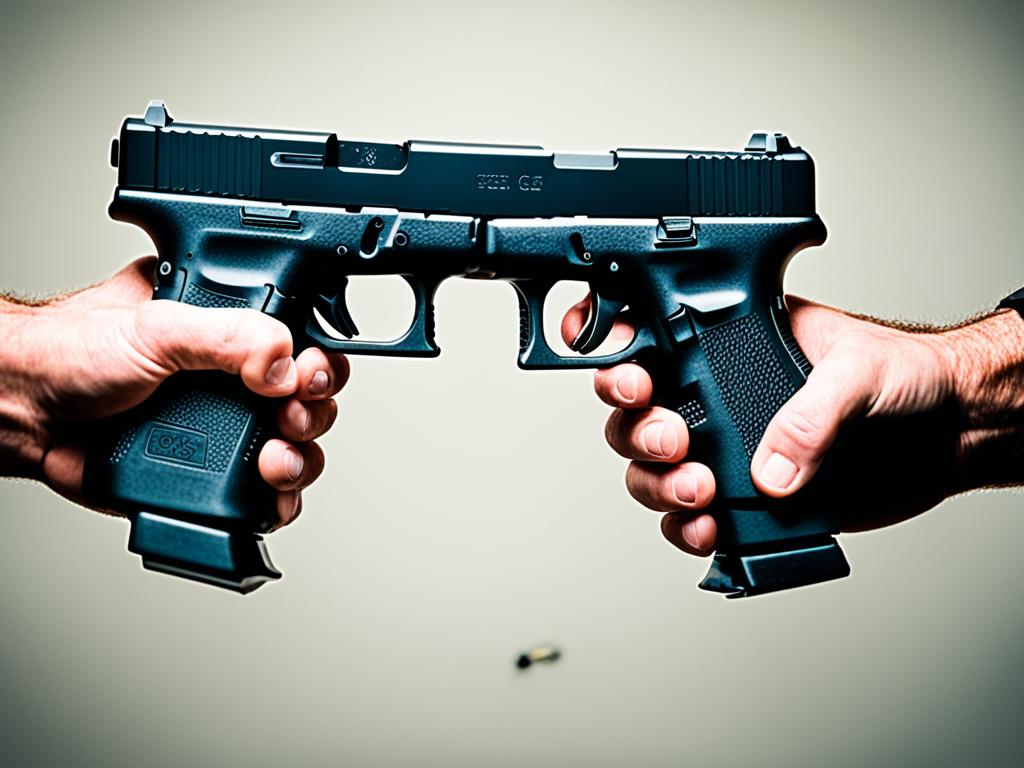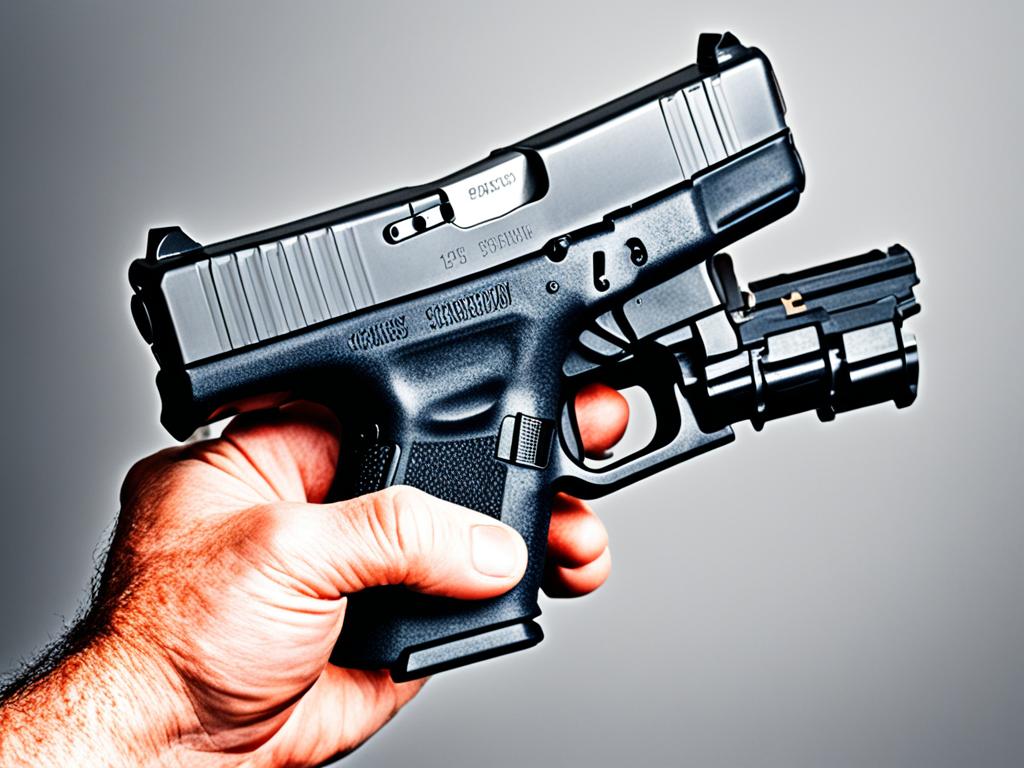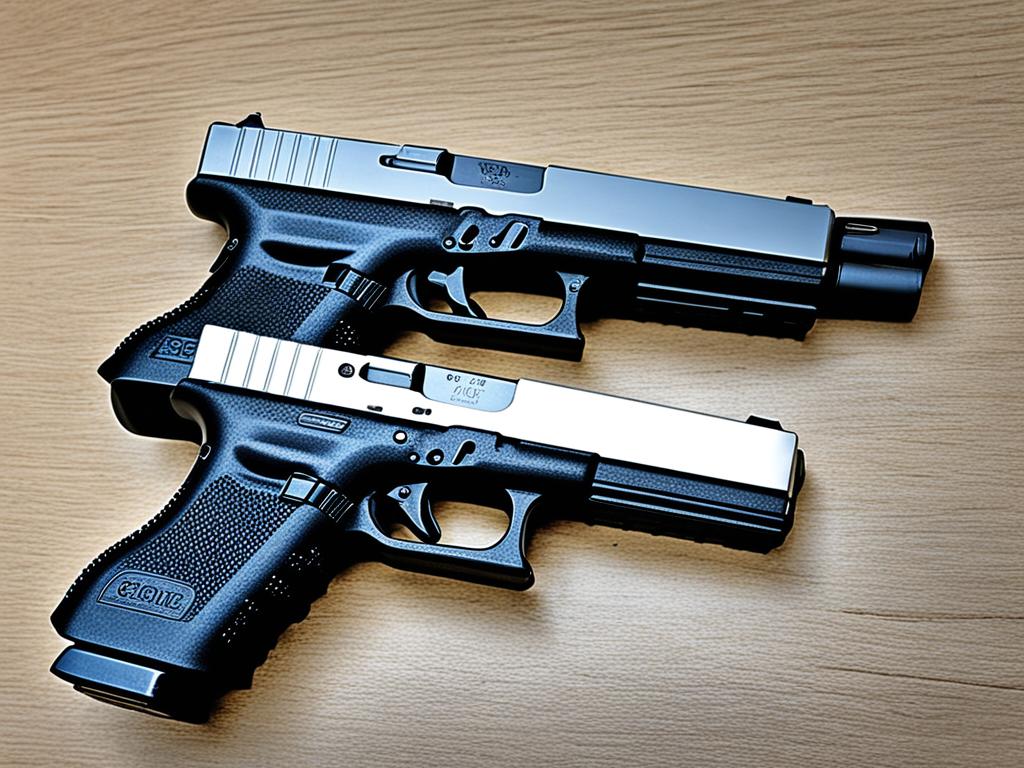Did you know that deciding on the ideal concealed carry firearm can be a daunting task? The popularity of the Glock 27 and Glock 26 for concealed carry makes it even more challenging. But fear not! In this article, we will delve into the differences between the Glock 27 and Glock 26 to help you make an informed decision. From firepower and size to handling and magazine capacity, we’ll explore all the key factors that can impact your concealed carry choice.
Key Takeaways:
- Understanding the differences between the Glock 27 and Glock 26 is crucial for choosing the perfect concealed carry firearm.
- The Glock 27 is chambered in .40 S&W, offering more stopping power, while the Glock 26 is chambered in 9mm, resulting in reduced recoil.
- When it comes to size and concealment, both pistols are subcompact, but the Glock 26 is slightly more concealable due to its shorter barrel length and overall height.
- Recoil sensitivity, magazine capacity, and the ability for caliber conversions are factors to consider when deciding between the Glock 27 and Glock 26.
- Ultimately, personal preference and individual needs should guide your choice for the perfect concealed carry firearm.
Firepower Comparison: Glock 27 vs Glock 26
When comparing the firepower of the Glock 27 and Glock 26, the main difference lies in the caliber. The Glock 27 is chambered in .40 S&W, while the Glock 26 is chambered in 9mm.
The .40 S&W round is generally considered to have more stopping power than the 9mm, but it also comes with increased recoil.
It’s important to consider your personal preferences and shooting abilities when deciding which caliber is right for you.
https://www.youtube.com/watch?v=NkyO4D2CWRk
| Glock Model | Caliber | Stopping Power | Recoil |
|---|---|---|---|
| Glock 27 | .40 S&W | High | Increased recoil |
| Glock 26 | 9mm | Lower | Less recoil |
As seen in the table above, the Glock 27 with its .40 S&W caliber offers higher stopping power, but it also comes with increased recoil. On the other hand, the Glock 26 chambered in 9mm provides a lower level of stopping power but with less recoil.
Ultimately, the choice between the two will depend on your individual preferences and shooting abilities. It’s recommended to try both firearms at a shooting range to determine which one feels more comfortable and manageable for you.
Size and Concealment: Glock 27 vs Glock 26
When it comes to choosing a concealed carry firearm, size and concealment are crucial factors to consider. In this section, we will compare the size and concealment capabilities of the Glock 27 and Glock 26 to help you make an informed decision.
Both the Glock 27 and Glock 26 belong to the subcompact pistol category, designed specifically for easy concealment. However, there are slight differences in their dimensions that may impact your decision.
The Glock 26 has a slightly shorter barrel length and overall height compared to the Glock 27, making it slightly easier to conceal. This shorter profile can make a significant difference when carrying concealed, as it minimizes the risk of printing or visibility under clothing.
Both pistols have similar widths and weights, ensuring that they are not overly bulky or uncomfortable to carry. However, the choice between the Glock 27 and Glock 26 primarily comes down to personal preference and comfort.
Ultimately, the right choice for you will depend on your body shape, wardrobe, and individual concealment needs. We recommend trying out both pistols in person to see how they feel and fit against your body, allowing you to make the best decision for your concealed carry needs.
| Glock Model | Barrel Length | Overall Height | Width | Weight |
|---|---|---|---|---|
| Glock 27 | 3.42 in | 4.17 in | 1.18 in | 21.89 oz |
| Glock 26 | 3.42 in | 4.17 in | 1.18 in | 21.71 oz |
Handling and Recoil: Glock 27 vs Glock 26
The handling and recoil of the Glock 27 and Glock 26 can vary due to the differences in caliber. The Glock 27, chambered in .40 S&W, tends to have more noticeable recoil compared to the Glock 26, chambered in 9mm. This is something to consider if you are sensitive to recoil or prefer a more manageable shooting experience.
If you are new to shooting or have limited experience with handguns, the Glock 26’s 9mm caliber may offer a smoother shooting experience with less perceived recoil. On the other hand, experienced shooters who prefer the increased stopping power of the .40 S&W round may find the Glock 27 more suitable for their needs.
To make an informed decision, it’s recommended to try both pistols at a range and assess how they feel in your hands. Some factors to consider when evaluating handling and recoil include:
- The weight and balance of the pistols
- Your ability to comfortably grip and control the firearm
- The impact of the recoil on your accuracy and follow-up shots
Ultimately, the choice between the Glock 27 and Glock 26 will depend on your personal preferences and comfort level with different calibers and recoil patterns.

Testimonials from Shooters
| Shooter | Glock Model | Experience | Comments |
|---|---|---|---|
| Jason Smith | Glock 27 | Experienced | “The Glock 27 packs a punch with its .40 S&W caliber. The recoil is manageable, but it definitely has more kick compared to my other 9mm handguns. It took some practice to get used to, but I appreciate the extra stopping power.” |
| Sarah Johnson | Glock 26 | Novice | “As a beginner, I found the Glock 26 to be easier to handle and control. The recoil was relatively mild, and I felt more confident in my ability to shoot accurately. It’s a great choice for those looking for a compact handgun with less recoil.” |
| Michael Thompson | Glock 27 | Experienced | “I chose the Glock 27 primarily for its firepower. The recoil is noticeable but manageable with proper grip and technique. With practice, it becomes second nature. It’s definitely a personal preference, and I find the larger .40 S&W round worth the bit of extra recoil.” |
Magazine Capacity: Glock 27 vs Glock 26
When comparing the Glock 27 and Glock 26, another important factor to consider is the magazine capacity. The Glock 27 typically comes with a 9-round magazine, while the Glock 26 comes with a 10-round magazine. Both pistols offer reliable capacity for self-defense purposes, but it’s worth noting that the Glock 26 has a slight advantage in this aspect.
However, it’s essential to mention that both the Glock 27 and Glock 26 have the ability to utilize higher-capacity magazines with aftermarket options. These aftermarket magazines can significantly increase the round count, providing you with more ammunition in a self-defense situation.
It’s crucial to be aware of and comply with your local laws and regulations regarding magazine capacity. Some states have restrictions on magazine capacity, and it’s important to ensure that you are following the law. Always check with local authorities or a knowledgeable firearms dealer to understand the regulations in your area.
Overall, while the Glock 27 and Glock 26 have different standard magazine capacities, both pistols offer options for increased capacity through aftermarket magazines, providing you with flexibility in your choice of concealed carry firearm.

Comparison Table: Glock 27 vs Glock 26 Magazine Capacity
| Glock Model | Standard Magazine Capacity | Aftermarket Magazine Options |
|---|---|---|
| Glock 27 | 9 rounds | Compatible with higher-capacity aftermarket magazines* |
| Glock 26 | 10 rounds | Compatible with higher-capacity aftermarket magazines* |
*Always check and comply with local laws and regulations regarding magazine capacity.
Caliber Conversion: Glock 27 vs Glock 26
One advantage of the Glock 27 is its ability to be converted to shoot other calibers. By simply swapping out the barrel, the Glock 27 can be converted to shoot 9mm or even .357 Sig. This versatility allows you to have multiple caliber options without needing to purchase a separate firearm. The Glock 26, on the other hand, is limited to its 9mm chambering.
If you’re someone who likes to have the flexibility to switch between calibers based on different shooting scenarios or preferences, the Glock 27 offers an appealing option. Whether you need the higher stopping power of .40 S&W or the affordability and availability of 9mm, the Glock 27 can adapt to your needs. This is especially useful for those who already own a Glock 27 and want to explore different calibers without investing in another pistol.
However, it’s important to note that caliber conversion for the Glock 27 does require purchasing the appropriate conversion barrel. Additionally, when converting to a different caliber, it’s essential to ensure that you’re using reliable and compatible ammunition. Proper training and knowledge about the specific conversion process and ammunition used are crucial for safe and effective shooting.
Comparison Table: Glock 27 vs Glock 26 Caliber Conversion
| Glock Model | Calibers | Conversion Option |
|---|---|---|
| Glock 27 | .40 S&W | 9mm, .357 Sig (with conversion barrel) |
| Glock 26 | 9mm | N/A |
As shown in the comparison table above, the Glock 27 offers greater versatility in terms of caliber options compared to the Glock 26. This can be a significant factor to consider if you prioritize having the ability to switch between different calibers for various shooting scenarios or personal preferences.
It’s crucial to remember that when converting calibers, there may be slight differences in recoil, ballistics, and overall performance. Therefore, it’s recommended to test-fire your converted Glock 27 with the new caliber to ensure its reliability and your comfort with the specific combination.
Ultimately, the decision between the Glock 27 and Glock 26 for caliber conversion depends on your specific needs, preferences, and shooting requirements. If you value the adaptability of multiple calibers, the Glock 27 provides an excellent option, whereas the Glock 26 is more focused on the 9mm caliber.
Making the Decision: Glock 27 vs Glock 26 for Concealed Carry
When it comes to choosing the perfect concealed carry firearm, the decision between the Glock 27 and Glock 26 ultimately rests on personal preference and individual needs. There are several factors to consider that can help guide your decision.
Firstly, consider your caliber preference. The Glock 27 is chambered in .40 S&W, offering a bit more stopping power compared to the 9mm chambering of the Glock 26. However, the .40 S&W comes with increased recoil, so it’s important to assess your shooting abilities and comfort levels with each caliber.
Size and concealability are also crucial factors to take into account. While both pistols are considered subcompact, the Glock 26 has a slightly smaller overall height and barrel length, making it slightly easier to conceal. However, both options are compact and suitable for concealed carry, so it comes down to personal preference and comfort.
Recoil sensitivity is another consideration. The Glock 27, with its .40 S&W caliber, tends to have more noticeable recoil compared to the Glock 26’s 9mm. If you are sensitive to recoil or prefer a more manageable shooting experience, the Glock 26 may be the better choice for you.
Other factors to weigh include magazine capacity and the option for caliber conversions. The Glock 26 typically comes with a 10-round magazine, while the Glock 27 has a 9-round magazine. It’s important to check local laws regarding magazine capacity. Additionally, the Glock 27 offers the advantage of caliber conversion, allowing you to swap out the barrel and shoot 9mm or .357 Sig, while the Glock 26 is limited to its 9mm chambering.
In the end, it’s crucial to test-fire both pistols if possible to evaluate their performance and find the one that feels most comfortable in your hand and suits your specific needs. Whether it’s the increased stopping power of the Glock 27 or the slightly smaller profile of the Glock 26, making an informed decision will ensure that you have a reliable and effective concealed carry firearm that you can confidently rely on.
FAQ
What is the main difference in firepower between the Glock 27 and Glock 26?
The main difference in firepower lies in the caliber. The Glock 27 is chambered in .40 S&W, while the Glock 26 is chambered in 9mm.
Which Glock model is easier to conceal, the Glock 27 or Glock 26?
Both the Glock 27 and Glock 26 are considered subcompact pistols, but the Glock 26 has a slightly shorter barrel length and overall height, making it slightly easier to conceal.
How does the Glock 27 compare to the Glock 26 in terms of handling and recoil?
The Glock 27, chambered in .40 S&W, tends to have more noticeable recoil compared to the Glock 26, chambered in 9mm. The handling and recoil experience may vary depending on personal preference and shooting abilities.
What is the magazine capacity of the Glock 27 and Glock 26?
The Glock 27 typically comes with a 9-round magazine, while the Glock 26 comes with a 10-round magazine. However, both pistols have the ability to use higher-capacity magazines with aftermarket options.
Can the Glock 27 be converted to shoot other calibers?
Yes, the Glock 27 can be converted to shoot other calibers by swapping out the barrel. It can be converted to shoot 9mm or even .357 Sig.
How do I decide between the Glock 27 and Glock 26 for concealed carry?
Choosing between the Glock 27 and Glock 26 for concealed carry comes down to personal preference and individual needs. Consider factors such as caliber preference, size and concealability, recoil sensitivity, magazine capacity, and the ability for caliber conversions.

Leave a Reply